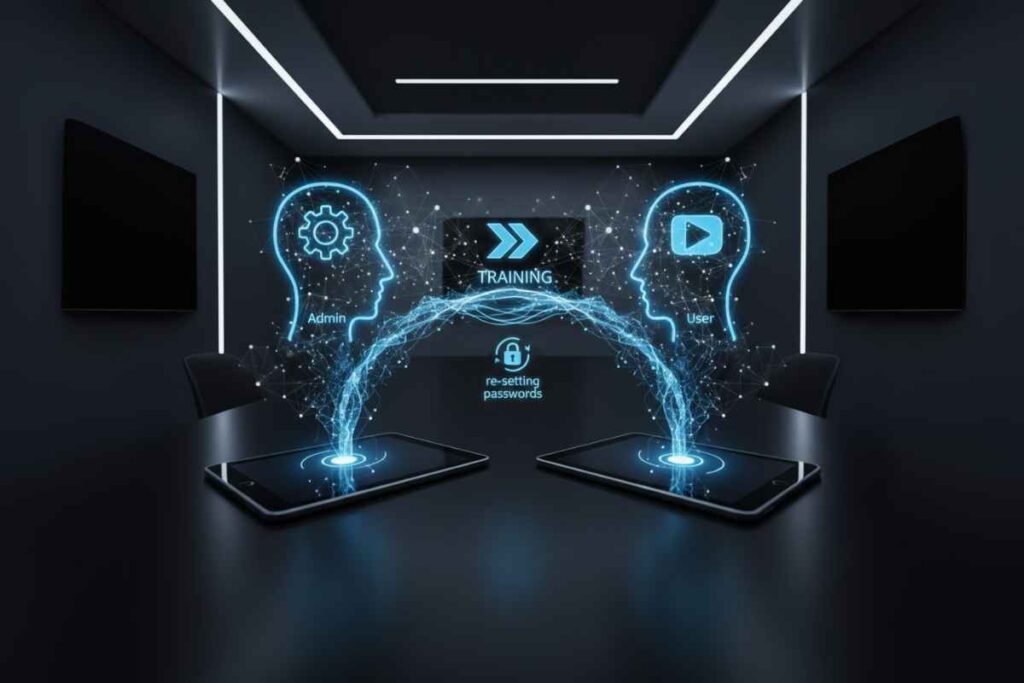Launch a Modern Learning Platform with Confidence
End-to-end support to compare, migrate, and roll out the right LMS/LXP – with a 90-day roadmap and measurable success metrics.

LMS/LXP Comparison Grid
Choosing between a Learning Management System (LMS) and a Learning Experience Platform (LXP) can be daunting. We simplify this with a clear comparison of these platforms, helping you pick what best fits your organization’s needs. Below is a snapshot of key differences:
Key Aspect | Traditional LMS (Management Focus) | Modern LXP (Experience Focus) |
|---|---|---|
Primary Purpose | Deliver and track formal learning (compliance, certifications). Top-down assignment of courses by admins. | Curate personalized, self-directed learning experiences. Bottom-up discovery driven by learners.
|
Content Source
| Primarily internal training content, structured into courses/curricula. Often SCORM-packaged modules enforcing standardization.
| Mix of internal and external content (videos, articles, podcasts). Supports varied formats via xAPI, enabling a rich content library beyond formal courses.
|
User Experience
| Focus on administrative needs: enrollment rules, compliance reports, and completion tracking. Learner interface is functional but often uniform for all.
| Focus on learner engagement: Netflix-like interface with recommendations, social learning (forums, sharing), and AI-driven suggestions based on user behavior. Tailored learning paths for each user.
|
Analytics & Feedback | Reports on course completions, quiz scores, and compliance status. Primarily quantitative tracking for L&D and HR audits.
| Advanced analytics on skills development and content usefulness. Gathers continuous feedback (likes, ratings) and can adjust recommendations. Insights on learning preferences and skill growth over time. |
Flexibility | Rigid structure – learners follow predefined curricula. Great for ensuring mandatory training is done, but less adaptive. | Flexible and adaptive – learners can choose content; platform adapts to interests. Encourages exploration and continuous learning beyond required courses. |
In summary, an LMS is ideal if you need to enforce and track mandatory training with precision (e.g. regulatory compliance, certifications), whereas an LXP shines in empowering employees to drive their own development in a more engaging way. Many organizations actually blend both: they maintain an LMS for compliance needs and layer an LXP on top for enrichment and personalized growth. We will help you evaluate your goals (compliance vs development emphasis), IT landscape, and user culture to choose the right platform or combination. By clarifying these differences in a simple grid, stakeholders can quickly align on what’s most important for your learning strategy.
Migration Checklist
Once you select a platform, the next challenge is migrating to it smoothly. Our team brings extensive experience with LMS-to-LMS and LMS-to-LXP migrations. We follow a comprehensive migration checklist to ensure nothing falls through the cracks. Key steps include:
Pre-Migration Planning
Establish a cross-functional migration team (L&D, IT, HR, vendor reps). Define clear objectives and scope – e.g. “Migrate all active courses and 2 years of training records from System A to System B.” Set a realistic timeline and freeze any non-essential changes in the old system during the migration period.


Content Inventory & Cleanup
Audit your existing content and data. We catalogue all courses, modules, users, completion records, etc. Redundant or outdated courses are identified for retirement (no need to migrate those). This is a chance to clean house, so your new platform starts with only relevant, high-quality content.
Data Export & Mapping
We export content (SCORM packages, videos, PDFs) and data (user info, enrollments, completions) from the old LMS. Each data element is mapped to its new format/location in the target platform. For example, if the new system uses different user role definitions or course structures, we create a mapping document. We also set up integrations (HR system, SSO, etc.) in the new platform to mirror what you had, or improve upon it.


Migration Execution
Using a combination of automated scripts and manual checks, we transfer content and data into the new platform. Content is uploaded and organized into the new taxonomy (categories, learning paths), and user records are imported (with login credentials, group assignments, etc.). We pay special attention to historical training records – ensuring completion status, certificates, and compliance records carry over accurately for auditing purposes.
Testing & QA
After migration, rigorous testing is done in a sandbox. We have administrators and a pilot group of learners perform tasks: launch courses, take quizzes, run reports. Any errors (like a video not playing, or a missing data field in a report) are fixed. We verify that “critical data syncs across systems” – e.g., the HRIS shows the same learner completion as the new LMS.


Admin and User Training
A new platform can be a big change. We train your L&D admins on the new system’s features (through live webinars and quick reference guides). We also provide communication templates to announce the new platform to users, highlighting improvements and any actions they need to take (for instance, re-setting passwords on first login).
Launch & Support Plan
Finally, we help you pick a go-live date (often aligned with the start of a quarter). We recommend running the old and new systems in parallel for a short period if possible, to ensure continuity. On launch, we have extra support available: for the first 2–4 weeks, we’ll assist with any issues (e.g. a user can’t see their assigned training) and monitor usage. Post-launch, we review adoption rates and feedback, ready to address any teething troubles.

By following this checklist methodically, we minimize migration risks such as data loss, extended downtime, or user confusion. In fact, one common pitfall is poor change management, which we preempt with strong communication and training. Our expertise ensures your migration is “no drama” – users log in on Day 1 of the new system and find what they expect, and stakeholders get the reports they need. We make a potentially complex process feel straightforward and secure.
90-Day Launch Roadmap
We pride ourselves on accelerating platform implementations. With proper planning, we can launch your new LMS/LXP in ~90 days. Here’s a high-level roadmap of those first 3 months:
Days 0–30: Plan & Prepare
In the first month, we finalize requirements and set the foundation. This includes the platform decision (if not already made), vendor contracting, and kickoff meetings with all stakeholders. We conduct the content inventory and cleanup during this phase. Additionally, we configure the new platform’s core settings (branding, user roles, basic course structure) and set up integrations (e.g. Single Sign-On, HRIS sync). By Day 30, the migration plan is in place and sandbox environment configured. (Milestone: Kickoff complete; all prerequisites like data access obtained.)


Days 31–60: Migrate & Build
The second month is execution-heavy. We migrate content and data into the new system (often iteratively, module by module, to catch issues early). Concurrently, any new features to be launched are built out – for example, if moving to an LXP, we might create initial personalized learning paths or set up the AI-based recommendation engine with your content. We also begin creating learner-facing materials (tutorial videos, FAQs about the new system). Regular check-ins ensure any snag (say, a SCORM package that won’t import) is resolved quickly. By Day 60, a substantial portion of content is in the new LMS/LXP and initial testing has begun. (Milestone: Test environment ready with real data; core courses loaded.)
Days 61–90: Test, Train & Go-Live
In the final month, we focus on quality assurance, training, and launch execution. We run full User Acceptance Testing with a pilot group, simulating as many scenarios as possible (new user enrollment, course completion, manager approvals, etc.). Any bugs are fixed promptly. Meanwhile, we conduct admin training sessions to ensure your team is confident managing the new platform. We roll out the communications plan to all learners (announcing launch date, why the change is happening, and how to get help). In the last week, we do a production cutover – syncing any data changes since the initial migration (to capture, say, new hires or training completed in the old system during the transition). Launch day is typically around Day 90: the new platform is live for all users! We stand by during the launch window to troubleshoot live issues. (Milestone: Successful go-live; ~80% of target users log in during the first month as an adoption benchmark.)

This 90-day roadmap is aggressive but achievable with our experienced team. We have templates for each step, which accelerates the process. For instance, our communication kits and training decks are 90% ready-to-go, needing only light customization – saving you weeks of drafting emails or help guides. Of course, the timeline can flex based on your organization’s size and complexity (we’ll be transparent if, for example, migrating 10 years of legacy data will add time). However, our goal is to deliver a functioning, user-ready learning platform in roughly a quarter of a year, so you start reaping the benefits quickly. With a fast launch, you can then focus on driving adoption and impact, rather than being stuck in implementation limbo.
Success Metrics
Implementing a learning platform is only as valuable as the results it delivers. From the outset, we define success metrics to track the platform’s impact on your organization. We help you set up dashboards and reports for key performance indicators such as:

User Adoption Rate
Are employees actually using the new system? We monitor the percentage of target users logging in and completing activities. For example, a common goal is “80% of employees complete their assigned onboarding in the LMS within the first month.” Strong early adoption indicates effective change management.

Engagement & Activity
Beyond logins, we measure engagement: average time spent on the platform, number of courses or learning assets accessed per user, social interactions (if LXP features like discussion or likes exist). Higher engagement suggests the platform is becoming a habit, not just a one-time requirement.

Completion & Compliance Rates
If compliance training is a use-case, we track completion rates and whether they happen before deadlines. An increase in on-time completions and a reduction in compliance-related incidents (e.g. expired certifications) is a clear success signal.

Performance Improvement
We look at business outcomes the learning aims to influence. For instance, reduced onboarding time for new hires is a measurable metric – “new hire time-to-productivity dropped from 8 weeks to 6 weeks after the new LMS launch.” Similarly, if the goal is sales enablement, we might correlate training completion with sales performance metrics.

Support Tickets & Issues
A metric sometimes overlooked is the number of support queries or issues related to the learning platform. Initially, there might be a spike (as users get used to it), but success is when this number quickly drops and stabilizes at a low level. Fewer “How do I find X course?” questions means the platform is intuitive and user-friendly.

ROI and Cost-Benefit
A key measure is ROI. This includes time saved (automation, fewer instructor-led sessions), better retention from improved learning, and performance gains. Metrics often tracked are reduced onboarding time, higher compliance, faster time-to-proficiency, and stronger engagement. Together, these show the LMS isn’t just tech—it drives real business value.
We will set these metrics in the planning phase and collect baseline data to compare against. Post-launch, we review these KPIs at 30, 60, 90 days and beyond. For instance, if adoption is lagging at 30 days, we might execute an extra engagement campaign (like a fun learning challenge with prizes) to boost usage. The goal is to avoid the “launch and leave” syndrome – we continue to work with you to ensure the platform delivers the intended outcomes.
By tracking and transparently reporting on these success metrics, we keep stakeholders confident and informed. It helps build the business case for future L&D investments as well – nothing speaks louder than data. ROI can indeed be measured by linking training activity to business outcomes, and we ensure you have those numbers to prove it. Our ultimate measure of success is when your learning platform is not just running, but driving measurable improvement in your workforce’s skills and performance.
